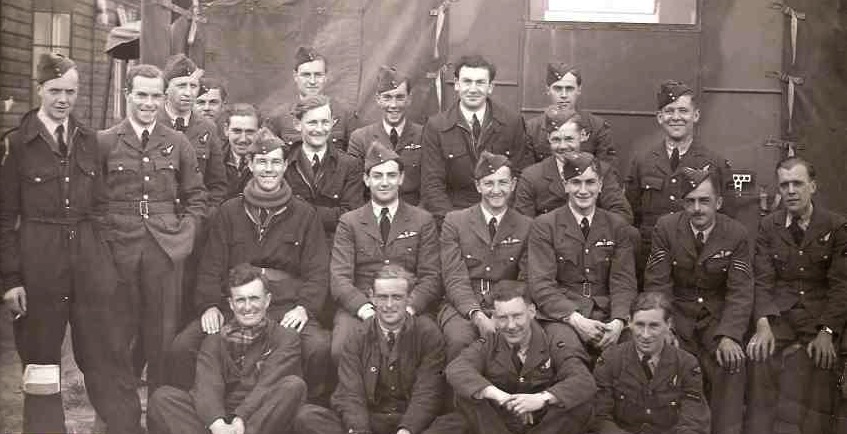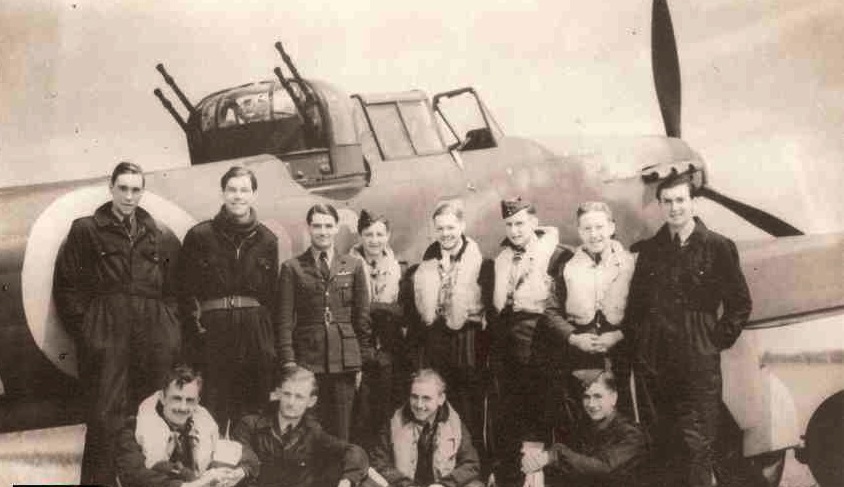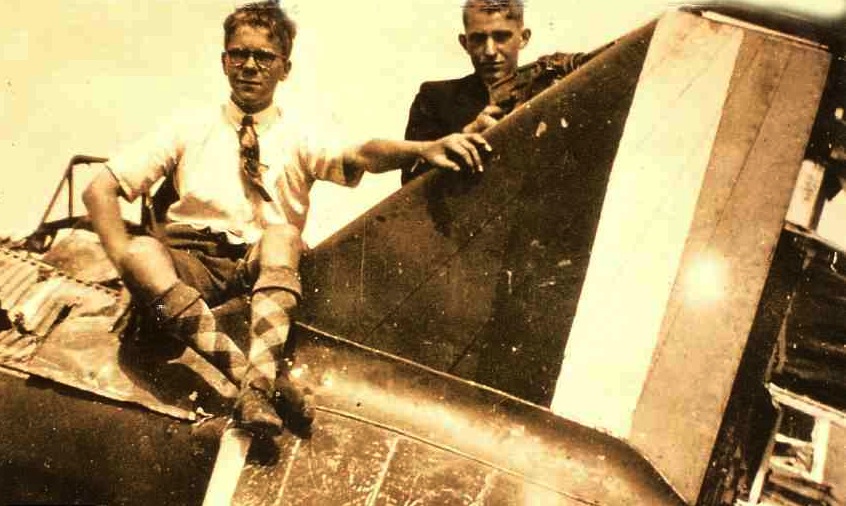Date: 13th May 1940 (Monday)
Unit: No. 264 Squadron
Type: Defiant I
Serial: L6965
Base: Duxford (via Martlesham)
Location: Zevenbergen
Pilot: P/O. Alexander McLeod R.A.F. Evaded. (1)
Air/Gnr: Sgt. Frederick Greenhalgh R.A.F. Evaded. (2)
REASON FOR LOSS:
Took off at 04.15 hrs from Martlesham along with 5 other Boulton Paul Defiant's together with 6 Spitfires from 66 Squadron. The object being to patrol the Dutch coast between Ijmuiden and the Hague to attack German troop transport.
They flew across the North Sea, making landfall about ten miles north of The Hague at 0515, after which all aircraft turned north. Over IJmuiden they were fired on by Dutch anti-aircraft guns located on the south side of the harbour. The guns were firing accurately but they ceased fire immediately the British signalled the Dutch letter of the day.
All aircraft turned about and flew south along the coast. More fire, this time German, was met over Maassluis which caused sections to take evasive action. Shortly after, the No. 66 Squadron Spitfires turned east towards Rotterdam where there were fires raging in various places while the Defiant's followed a more southerly route. Approaching Rotterdam, the crews of both flights saw about seven German Ju 87 Stukas (belonging to 12. Staffel of Lehrgeschwader 1) dive-bombing a target to the south-east.
The Defiant's went in to the attack and a ferocious air battle developed. Shortly after, Bf 109s from 5. Staffel of Jagdgeschwader 26 joined the battle, which then developed into a series of individual dogfights.
Pilot Officer Alex McLeod's report of the action on May 13 reads as follows:
"I was Green 2 pilot of a Defiant aircraft in formation led by Pilot Officer Greenhous along with three other Defiants led by Flight Lieutenant Skelton and six Spitfires of No. 66 Squadron, also in Vee formation in sections of three. We patrolled the Dutch coast and encountered anti-aircraft fire north of the Hook of Holland, without seeing any enemy aircraft.
We then proceeded to Rotterdam and formation broke up west of Rotterdam to attack, as far as I could see, four Ju 87s who were dive-bombing near a railway about ten miles south of Rotterdam.
I attacked a Ju 87 which was making away from our own aircraft and after a good many bursts from my air gunner, which were mostly given from above, I then saw him dive in flames. I was then immediately attacked by an Me 109 and tried to bring my aircraft in position for my gunner to shoot at the Me 109 by turning steeply to starboard.
After an exchange of bursts from either side my gunner reported that all four guns were out of action. I avoided the enemy by increasing the rate of turn. Having evaded the enemy for the present my gunner was able to rectify some of the guns by re-cocking."

(Source Jan Jolie)
"I then noticed two Me 109s on the tail of another Defiant. I went to his aid but an Me 109 came on my tail again and my gunner exchanged shots. I carried out the same action as before but turned so quickly that I experienced a high speed stall and a spin, and on coming out I noticed that both starboard and port petrol tanks were on fire. The gunner also told me that the guns were finally out of action perhaps due to lack of ammunition, he could not say. Being useless as far as fighting was concerned, I proceeded south-west and force-landed near Zevenbergen. Unfortunately I landed in Dutch territory then in hands of the German army.
‘My gunner and I hid in the cellar of a house belonging to Dutch inhabitants as a German armoured car stopped outside the house. The Germans searched for us, looked in the cellar, but did not see us, as we were behind the steps leading down to the cellar. The Germans occupied the house for about three to four hours and then left for a short space of time in which we left also.
When they came back we were only about 200 yards from them lying in a ditch and from then onwards it was a case of hide and seek until we came to the river. I have forgotten to mention that the aircraft was completely burned out and we were dressed in overalls and civilian overcoats above our uniforms."
"My gunner not being able to swim, we proceeded up the river towards a bridge with a railway crossing over the river, but came across more Germans guarding the bridge.
They shouted something to us but I pretended not to hear, turned round and sat with my gunner on the edge of the river. We stayed there for about 30 minutes and the Germans did not worry us.
We sauntered off in the other direction down the river for some distance until we came to a house on the other side. We kept the house under observation for some time to see if it was occupied by Germans, but it did not seem to be, so we whistled across to the occupants who rowed us over and gave us the direction of a Dutch regiment, the 6th Infantry, who were about six kilometres away. On the way we passed a village near Hoeven which was being bombed by three He 111s with 12 Me 109s guarding them.
As the He 111s were bombing up and down the wind the Bf 109s were circling in line astern in sections of six about the same height as the He 111s, that is 1,000 feet. In the course of the morning of May 13 fully 50 Me 110s must have passed over us making for the coast in formations of 15. The Me 110s did not keep any definite formation of 15 but kept wide apart and changed positions somewhat like rotation, but erratic, height being changed constantly."

(Source Jan Jolie)
"We eventually caught up with the Dutch regiment and made our identity known. This regiment was going to retreat to Antwerp that night as they were being gradually encircled and the commander did not expect to get there as some armoured cars were supposed to be on their way to head them off from Belgium.
We decided to carry on on our own but the same Dutch regiment picked us up near the border of Belgium and took us to Antwerp. I made my identity known to the French Army through the British Consul General, Mr Fisher. From there we proceeded to Ghent where the British Vice-Consul, Mr Whipp, was kind enough to take us to Ostend and obtain a passage on a ship, the Prince Leopold, which was to take British refugees to Folkestone.
During the night of May 16/17, while on board waiting to sail, an aircraft, with engines off, dropped bombs. One landed about 100 yards away The passengers were transferred next morning to a British ship, but we ourselves came over to Dover in the destroyer D77, which convoyed the passenger ship over, landing at Dover on the 17th at 2000 hours.
‘During my passage through Holland and Belgium it appeared that the civilian population was extremely demoralised and that the Germans were concentrating almost as much on ground-strafing civilian refugees as they were on military formations. Another thing which struck me forcibly was that the Dutch regiment, the 6th Infantry, seemed to be very badly officered. The commanding officer was in a state of panic and could not make up his mind. On the other hand the troops appeared to be of an excellent type but were not very well disciplined and they appeared to argue with the officers."
A young Dutchman, Piet Jongmans who lived at Hazeldonkse Zandweg at Zevenbergen, witnessed the events surrounding the crash of McLeod and Cox:
"My father, who was in the fields behind our farm, saw it happen. I had just finished milking the cows and was on my way home to get changed. Without hesitation my father ran towards the plane to provide help.
The crew was already busy burning as much of the aircraft as possible. One of them put on my father's coat and the whole group came towards our house. Immediately their problems started. I took their backpacks and the parachute of one of them and put them in the coal shed. This shed had a door at the front but this was not conspicuous as it had no handle and looked as if it was fixed shut. It was important to make the British airmen disappear from the scene as quickly as possible.
We therefore very swiftly hid them in one of the cellars under the house."

(Source Jan Jolie)
"They were barely there when Germans of the so-called Totenkopf-Regiment stood in front of our house and asked everyone where the English had gone. I was standing outside and they asked me if by chance I was an Englishman. When I denied this I had to show my papers.
I had nothing else but an inoculation certificate, which they thought was sufficient. They pushed a gun in my back and I was forced to go and look for the English airmen everywhere. First the shed in the garden was searched but fortunately our other shed escaped their attention.
Next the house was searched from top to bottom without finding anything. Then we went to the cellar and I thought “Now it will happen”, but the Germans only inspected it very superficially. They did not find anything because the second cellar is not easily visible."
"Subsequently I was taken away by the Germans. They asked all kinds of things and finally let me go after an hour but kept a tight watch on everything.
Later my father told me that I should go to the village as soon as possible to prevent being picked up again. I returned later to find that the Germans were there but it turned out that the English airmen had meanwhile left our house.
My father had given them a raincoat and sent them on their way in the direction of Antwerp. As a cattle trader my father knew every little road in the area right up to the Belgian border.
Later we learned that Willem Rommens helped them to get across the Mark River so that they could continue their journey via Etten-Leur to Antwerp."

(Source Jan Jolie)
"The evening after the airmen had gone, a large group of German soldiers came to our house. The next day they were followed by a group of soldiers who stabled their horses in our barn and themselves occupied the kitchen. AII the time they kept asking about the crew of the British aircraft, which was rather nerve-racking as we had not yet had the opportunity to hide the incriminating belongings of the Englishmen.
My father kept worrying what would happen if the Germans found the stuff. He said that it would be the end of us if that happened. I told him that I would hide all the material during the church service, because the soldiers would be exercising at that time and the family would all be in church. I said I would not tell him where I had hidden it and, if I did it on my own, nobody needed to know.
‘In the barn we had a manure pit that was no longer being used. It was constructed from six large concrete rings.
I put all the material into the pit and put two trailer loads of earth on top. Even so this work caused me a terrible fright. As I dumped the first load of earth on the goods everything bulged over the edge of the pit. For a moment I was lost to know what to do but I quickly figured out that the air trapped in the parachutes was pushing everything upwards. With a pitchfork I made holes in the parachutes and then dumped the rest of the earth on top. The whole load of incriminating evidence sank beautifully to the bottom of the pit and I could cover it with the lid."
On their return to England McLeod and Cox rejoined No. 264 Squadron at Manston. They were allocated Defiant L7007 in which they carried out two patrols over Dunkirk on May 23. These two sorties were the last that they flew together. McLeod continued flying L7007 but now with Jack Hatfield (who had been in Blue 1 on May 13) as his gunner. They carried out two further patrols to Dunkirk on May 27.
The next day, May 28, McLeod and Hatfield took off at 1140 hours together with nine other Defiants of No. 264 Squadron for a patrol over the Belgian coast. Flying south from Ostend the formation was attacked by Bf 109s of 6./JG51. Squadron Leader Philip Hunter, the squadron CO, ordered his aircraft into close line astern and flew a tight defensive circle. His gunner, LAC Frederick King, shot down the first Bf 109 that attacked and also managed to shoot down a second.
Shortly after the battle commenced, L6959 flown by Flight Lieutenant Edward Whitehouse and Pilot Officer Horace Scott, crashed into the sea, killing both airmen.
The next attack by the Bf 109s broke up the British formation. In the ensuing dogfight, L6953 flown by Sergeant L. C. W. Daisley and LAC Harold Revill, was shot down, as was L7007 of McLeod and Hatfield. Both crews were killed.
The surviving seven Defiants returned to base safely.
The following day, LAC Cox was back on operations again, this time flying with Pilot Officer Desmond Kay. Cox survived the war and died on February 23, 1953.
The Balance Sheet May 13th 1940 (HERE)
Researched by Jan Jolie (Dutch researcher)


The British Library is preserving this site for the future in the UK Web Archive at www.webarchive.org.uk All Aircrew Remembered on our Remembrance pages, are therefor not just remembered here, but also subsequently remembered and recorded as part of our nation’s history
and heritage at The British Library.